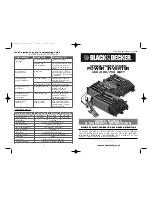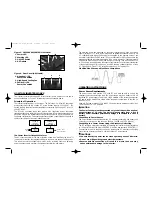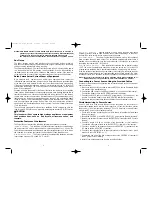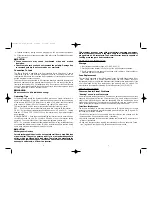
5
Short Circuit Protection —
Reverse polarity or short circuit condition may cause
external or internal fuses to open and may cause irreversible damage to the Power
Inverter. Take extra care to insure a proper polarity hook-up.
Overload Protection —
The unit will automatically shut down when the continuous
draw exceeds the unit’s rated output. The unit should automatically restart after a
shutdown due to overloading once the load is reduced. If it fails to do so, manually
reset using the inverter’s ON/OFF switch.
Over Temperature Protection —
If the temperature inside the Power Inverter reaches
150°F, the unit will automatically shut down. Allow the unit to cool for at least 15
minutes before restarting after a heat-related shutdown. Unplug unit while cooling.
If the low voltage alarm sounds when the battery is fully charged, follow the steps for
solving lack of output power in the Troubleshooting section of this manual. The alarm
will sound if there is an excessive voltage drop between the battery and the inverter.
Note:
It is normal for the alarm to sound while the unit is being connected to, or
disconnected from, the power source. This is not indicative of a problem.
Connecting to a Power Source Using the Provided Cables
Use the provided cables and connect the Power Inverter directly to the 12 volt power
source as follows:
1. Make sure the Power Inverter power is turned OFF and that no flammable fumes
are present in the installation area.
2. Connect the RED cable to the RED post marked (+) on the back of the inverter .
Connect the battery clip to the POSITIVE terminal of the battery.
3. Connect the BLACK cable to the BLACK post marked (–) on the back of the
inverter. Connect the battery clip to the NEGATIVE terminal of the battery.
4. Make sure that all connections between battery clips and terminals are secure.
Direct Hardwiring to Power Source
Use #12 AWG wire if the inverter to power source connection is 4 feet or less. For
longer cable lengths use #8 AWG wire for lengths to 10 feet. In either case, protect
the positive (+) wire from shorts by installing a 50 to 75 Amp fuse or circuit breaker
close to the DC power source (battery) terminal.
1. Check to be sure the inverter’s power switch is turned off and that no flammable
fumes are present.
2. Identify the POSITIVE (+) and NEGATIVE (–) DC power source (battery) terminals.
3. Install a fuse holder or breaker close to the POSITIVE (+) terminal of the DC source
(battery).
4. Connect a length of wire on one side of the fuse holder or circuit breaker.
Connect the other end of the wire to the POSITIVE (+) terminal of the inverter.
5. Connect a length of wire between the inverter’s NEGATIVE (–) terminal and the
DC power source NEGATIVE (–-) terminal.
6. Connect a short length of wire to the other terminal of the fuse holder or circuit
breaker. Mark it “POSITIVE” or “+”.
7. Connect the free end of the fuse or breaker wire to the POSITIVE (+) terminal of
the DC power source (battery).
8. Insert a fuse appropriate to the inverter in the fuse holder.
4
Notes:
Most vehicle accessory outlet circuits have fuses rated at 15 to 20 amps or
greater. To operate at full wattage, either use the battery clip cable (supplied)
or directly wire to the power source with user-supplied wire and fuse.
The majority of modern automobiles, RVs and trucks are negative ground.
Run Times
The Power Inverter may be used whether or not the vehicle’s engine is running.
However, the inverter may not operate while the engine is starting since the battery
voltage can drop substantially during cranking.
The unit draws less than 0.5 ampere from the battery when it is not supplying power
to a load and switch is in ON position. In most instances, it can be left connected to
the battery when not in use, since it draws so little current. However, if the vehicle is
to remain unused for several days, disconnect the Power Inverter from the battery.
Rated Versus Actual Current Draw of Equipment
Most electrical tools, appliances and audio/video equipment have labels that
indicate the power consumption in amps or watts. Be sure that the power consumption
of the item you wish to operate is rated at or lower than the inverter’s output rating.
If the power consumption is rated in amps AC, simply multiply by the AC volts (115)
to determine the wattage. The Power Inverter has overload protection, and will shut
down if it is overloaded.
Resistive loads are the easiest for the Power Inverter to run. However, larger resistive
loads, such as electric stoves or heaters, usually require more wattage than the Power
Inverter can deliver on a continuous basis. Inductive loads, such as TV’s and stereos,
require more current to operate than do resistive loads of the same wattage rating.
Induction motors, as well as some televisions, may require 2 to 6 times their wattage
rating to start up. The most demanding appliances are those that start under load,
such as compressors and pumps. Testing is the only way to determine whether a
specific load can be started and how long it can run. The unit will simply shut down
if it is overloaded.
The unit should automatically restart after a shutdown due to overloading once the
load is reduced. If it fails to do so, manually reset using the inverter’s ON/OFF switch.
CAUTION
This inverter will not operate high wattage appliances or equipment
that produce heat, such as hair dryers, microwave ovens, and
toasters.
Protective Features of the Inverter
The Power Inverter monitors the following potentially hazardous conditions:
Low Battery Voltage —
This condition is not harmful to the inverter, but could damage
the power source. An alarm will sound when input voltage drops to 11.0 Volts. The
Power Inverter automatically shuts down when input voltage drops to 10 volts. When
the condition is corrected, the inverter can be turned off, then turned back on.
Over Voltage Protection —
The Power Inverter will automatically shutdown when the
input voltage exceeds 15.5 volts DC ± .5 volt DC.
VEC1045_46_47_BD_Manual 4/28/05 5:16 PM Page 4
























